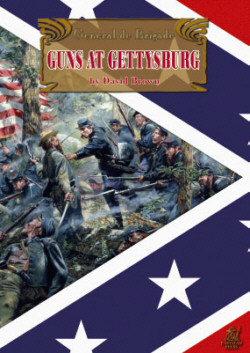|
|
|||||||||||||||||||||||||||||||||||
 |
|
The Rules Directory only works if you help. Write a review. Get the review template here. |
|
TITLE: Guns At Gettysburg (2007) AUTHOR: Dave Brown PUBLISHER: Caliver Books PUBLICATION DATE: 2007 WEB SITE/SUPPORT FORUM:
PRICE: $30.00 (In 2009) REVIEWED BY: Mark “Extra Crispy” Severin PERIOD COVERED: The American Civil War THE BOOK: When Guns At Gettysburg arrives in the mail, you get a very nicely produced book. The cover is a glossy full color and all the interior pages are nice coated stock. I have nothing against rules printed on ordinary copy paper, but I admit there’s something very satisfying about a high quality paper (okay, okay, nothing to do with the game at hand but, hey, it’s my web site!). At the center is the player summary card which is laminated for durability. SCOPE: Guns At Gettysburg is a tactical game of the American Civil War ARMY SIZE: Like it’s father General de Brigade, GAG uses a 1:20 figure ratio resulting in large units. An army is therefore likely to be quite large, although the game also works for smaller scenarios with just a handful of units per side. BASE UNIT: The base unit is the infantry or cavalry regiment. GAME SCALES:
BASING SIZES: Basing in 15 mm follows the accepted standards of Fire & Fury and Johnny Reb III. Infantry should be based on an 8-10 mm frontage per figure in two ranks. Functionally this means a base 20 mm wide by however deep is needed. Cavalry get 10 - 15 mm per figure and artillery 30 to 40 mm per gun. No depths are given except to note that as depths will be so far out of ground scale in any case, whatever the miniatures need to fit will work fine. TURN SEQUENCE:
GAME MECHANICS: Orders: Each brigade must be operating under one of the following: Assault, Engage, Support, Move, Hold, Retire. Each carries with it requirements for closing with the enemy (or not), objectives to be taken/held etc. Changing a brigade’s orders requires a die roll by either the C-in-C or a brigade commander. This means you only have an opportunity to change two orders per turn - one by the C-in-C and one by a brigade general, and neither is guaranteed! Charging: Charges are almost an entire game in themselves. Fortunately the rules are written in a flow-chart style so each step from declaring the charge, to evading the charge, defensive fire and opportunity charges are clearly laid out. I do wish, however, that a charge summary had been included on the summary card. One of the four pages of the card is simply a black and white reproduction of the cover - that space could have been more profitable used by having an actual Charge “low” diagram. Movement: Movement is quit straightforward and includes the costs for many tactical moves that larger scale rule sets may ignore. These include the cost to recall skirmishers, step back, and change formation. One small wrinkle to watch out for. If a unit goes prone, when ordered to stand up a die roll is required and a Brigadier must be within 12”! There is also a penalty for large regiments (40+ figures) to execute and formation change. Fire Combat: Fire combat is a simple affair. Roll 2D6, add and subtract some modifiers and cross index with the number of figures firing. The result is the number of casualties inflicted. Artillery fires the same way though with separate DRMs and a separate casualty chart. Melee: Melee is likewise a relatively uncomplicated affair. Each side rolls 2D6 and the high roll wins. The difference between the two rolls dictates the results in terms of retreats, routs and morale checks. The difference also dictates casualties. Winning infantry inflict one casualty for every point of difference, while losing infantry only inflict one casualty for every twelve points of difference. Winners must check to see if they can (or must!) pursue or not. There are rules and modifiers for reinforcing melees, for having numerical superiority etc. In fact there are quite a few modifiers to be checked but as a summary chart is provided this should really be no issue. Morale: Like everything else, morale checks are simple 2D6, add modifiers and consult the Morale Results Table. There are columns for each of 5 reasons for checking morale, so your likely results are different if you are attempting a charge versus being charged. REVIEWER’S COMMENTS: All in all, there is nothing here that is terribly innovative or new. All of the mechanisms are tried and true. However, they are very clearly explained and good, comprehensive example abound. The illustrations are simple block diagrams instead of photos but they clearly communicate the rules. PLAYER’S COMMENTS: Not played. |
|
[Home] [15mm World] [Reviews Home] [How To] [Beginners Guide] [Gamer's World] [Spanner & The Yank] [Points of View] [The Annex] [Links] [Say Howdy] [Corporate Schill] [Rules Directory] |
 |
